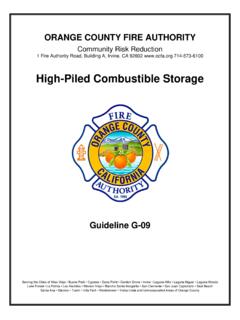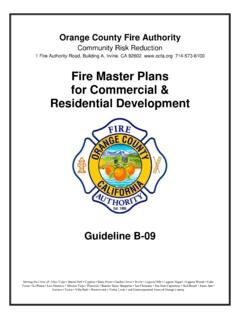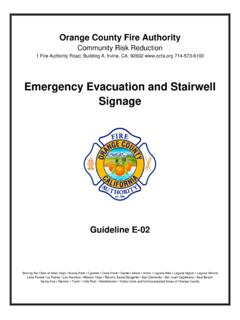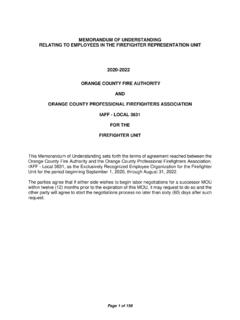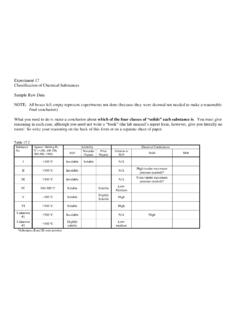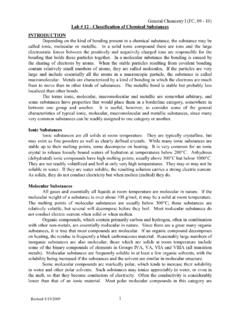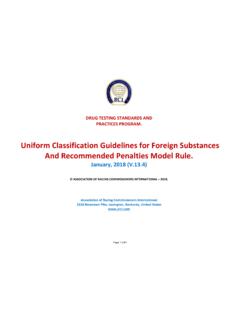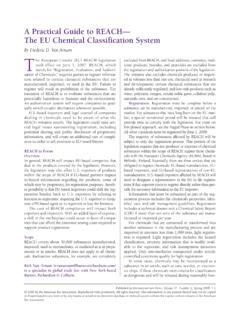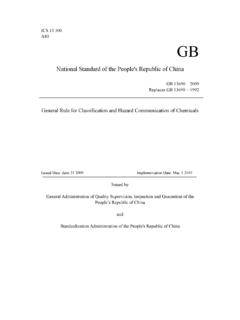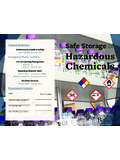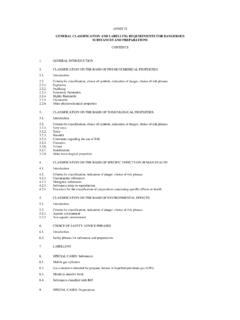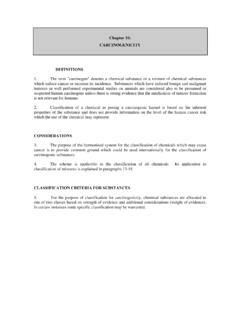Transcription of Completion of the Chemical Classification Packet - ocfa.org
1 Orange County Fire Authority Community Risk Reduction 1 Fire Authority Road, Building A, Irvine, CA 92602 714-573-6100 Completion of the Chemical Classification Packet Guideline G-06 Serving the Cities of Aliso Viejo Buena Park Cypress Dana Point Garden Grove Irvine Laguna Hills Laguna Niguel Laguna Woods Lake Forest La Palma Los Alamitos Mission Viejo Rancho Santa Margarita San Clemente San Juan Capistrano Seal Beach Santa Ana Stanton Tustin Villa Park Westminster Yorba Linda and Unincorporated Areas of Orange County Completion of the Chemical Classification Packet : G-06 July 1, 2020 1 Completion of the Chemical Classification Packet PURPOSE This guideline was developed to assist businesses in complying with the provisions of Chapter 50 of the 2 0 1 9 California Fire Code (CFC). It is applicable to any business storing, using, or handling hazardous materials.
2 Hazardous materials are chemicals that pose a physical hazard (like fire or explosion) or a health hazard (like toxic or corrosive). This guide treats hazardous waste as a hazardous material. This Chemical Classification Packet meets the requirements of the HMIS (Hazardous Materials Inventory Statement) in the CFC. SCOPE All chemicals need to be classified with respect to their individual hazards, so a determination can be made relative to the Maximum Allowable Quantity (MAQ). This will allow the proper fire and life safety protection systems to be in place. OCFA will perform a MAQ review taking into account: controls areas, open vs. closed use, and indoor vs. outside storage. SUBMITTAL REQUIREMENTS Attached are sample Chemical Classification forms, an explanation of the fields requiring Completion , and a list of hazard classes as defined by the 2019 CFC. This Packet should be used to classify all chemicals stored, used, or handled at your facility regardless of the quantities of each Chemical .
3 The following three separate lists require Completion for each Chemical Classification Packet : 1. Chemical Classification Form (shows entire inventory) 2. Chemical Classification Summary Sheet (shows totals by hazard class) 3. Chemical Classification Summary Totals (shows totals by area) Safety Data Sheets (SDS/MSDS) may be submitted along with the contact information from the preparer of the Chemical information. A basic floor plan drawing of the facility is required to show Chemical storage and use locations, and any special control areas. MIXTURES Classifying the hazards of mixtures can be complicated, especially if the individual components themselves have multiple hazards. Dilution almost always lessens the hazard of the pure Chemical . Information listed on the SDS/MSDS may not be specific to the diluted mixture. Sometimes they list data from one of the most hazardous components instead. OCFA will make the final determination of the most appropriate hazard class.
4 If there is any question as to the accuracy or completeness of the information provided, you will be required to make corrections and resubmit your Chemical Classification Packet . A third-party technical or engineering report may be required if your Chemical information cannot be verified. Completion of the Chemical Classification Packet : G-06 January 1, 2020 2 FORMS Use the three sample forms in completing your own documents and assure all fields are completed. Provide the name of the facility, address, and area addressed by the Packet , if applicable, on each page of the Chemical Classification Packet . Use only the definitions provided to classify your chemicals into all applicable categories. Incomplete or incorrect forms may be returned. 1. Chemical Classification Form - Sample #1 in this document shows a list of all the chemicals used at a sample facility (a blank version of this form has been included at the end of this guideline for your information).
5 Examples of chemicals have been provided with all fields completed. Note: Chemicals that have the same components and hazard classes may be grouped together. For example, if 10 gallons of blue paint and 20 gallons of red paint have the same basic components, they can be listed as 30 gallons of paint. In addition, all items such as motor oil, hydraulic fluid, antifreeze, waste motor oil, etc. are all classified as Class IIIB Combustible Liquids and can be grouped together under the heading, CL-IIIB Liquids. Conversely, if you have several containers of isopropyl alcohol at different concentrations, list these separately as they may be classified differently based on the individual flash points. The following list explains the information required in each field: COMMON NAME Chemical NAME % COMP CAS # FORM QUANT. STORED QUANT. IN USE (Open/Closed) LOCATION (Storage & Use) HAZ CLASSES JUSTIFICATION A. Common Name: This is the name of the Chemical as it is used in your industry.
6 Sometimes it will be a trade name, such as Purple K , WD40, Techron, muriatic pool acid, or Safety Kleen. B. Chemical Name and %: This is the technical name for the pure Chemical . If the Chemical is a mixture, list the components of the mixture with their composition percentage. If it is a pure Chemical , list the percent concentration as 100%. If the product is a water solution, list the percent concentration. C. CAS Number: The Chemical Abstract Service number can usually be found on the SDS/MSDS or from the Chemical supplier. D. Form of a product: The form of a product is: solid, liquid, gas, or aerosol. Solids shall be reported in pounds, liquids in gallons, and gases in cubic feet. Liquefied petroleum gas (LPG) and cryogenic liquids are treated as liquids and reported in gallons. Aerosols shall be reported in pounds. For example, if some of the components in an aerosol make it toxic or corrosive, then that aerosol amount must also be included in the summary table for those hazard classes, in gallons.
7 E. Quantity Stored: Total amount within closed containers in the building or area. F. Quantity in Use: The amount in use in the process/dispensing area(s) of the building. Also, indicate whether the amount in use is in an open or closed system. G. Location: In a cabinet, QC lab, high-piled rack system, outside tank, etc. Completion of the Chemical Classification Packet : G-06 January 1, 2020 3 Interior Storage: Exterior Storage: 110 gal Open System Use: Closed System Use: H. Hazard Classes: There are often several hazards for each Chemical (classifications may be abbreviated in Attachment 1). All hazard classifications for the Chemical must be listed. Carcinogens, Irritants, Other Health Hazards, Radioactive, and Sensitizers, are no longer regulated by the Fire Code; there is no need to show the totals for these chemicals (see Sample #3). I. Justification: This column can be used to indicate where you obtained the information for the Classification of the material.
8 For example, if you classified a Chemical as toxic, provide the LD50 data, likewise for corrosives and flammables the pH or the flash point data. 2. Chemical Classification Summary Sheet - Sample #2 shows a list of the chemicals from the sample Chemical Classification Form. To develop this sheet, reorganize the information from the Chemical Classification Form and sort the information by hazard class. The following is a list of the required information: Chemical Name Amount Stored Open Use Closed Use Location of Storage Location of Use Chemical Name Location of Use Amount Stored Totals for Interior Storage Open System Use Amount Totals for Exterior Storage Closed System Use Amount Totals for Open System Use Location of Storage Totals for Closed System Use NOTE: Chemicals with multiple hazards are listed under each hazard Classification (example is concentrated sulfuric acid is corrosive, toxic, and class 1 water-reactive).
9 3. Chemical Classification Summary Totals - Sample #3 shows a list of the totals by hazard Classification for a given building and/or area. The following is a list of required information for each hazard class and an example of a completed section of the summary: A. Hazard Class B. Total amount stored or used inside the building C. Total amount stored or used outside the building D. Total amount used in open systems E. Total amount used in closed systems SAMPLE: FL-IB: CL-II: Interior Storage: 20 gal Exterior Storage: 55 gal Open System Use: Closed System Use: Completion of the Chemical Classification Packet : G-06 January 1, 2020 4 4. Reference Books - The following reference materials may be useful in the Classification of hazardous substances at your facility: A. The Merck Index, 10th ed., Merck & Co. Inc., Rahway, New Jersey 07065 (1983) B. Sittig, Marshall, Handbook of Toxic and Hazardous Chemicals and Carcinogens, Noyes Publications, Mill Road, Park Ridge, New Jersey 07856 C.
10 Lewis, Sr., Richard J., Sax's Dangerous Properties of Industrial Materials, 8th ed., Van Nostrand Reinhold Publications, 115 Fifth Avenue, New York, New York 10003 D. Handbook of Compressed Gases, Compressed Gas Association Inc., 1235 Jefferson Davis Highway, Arlington, Virginia 22202 E. Fire Protection Guide to Hazardous Materials, 10th ed., National Fire Protection Association, 1 Batterymarch Park, Box 9101 Quincy, Massachusetts 02269 F. Fluer, Larry, Hazardous Materials Classification Guide, International Fire Code Institute, 5360 Workman Mill Road, Whittier, California, 90601 G. Genium s Handbook of Safety, Health, and Environmental Data for Common Hazardous Substances H. OCFA s Top 100 Chemical list found on the website HAZMAT IDENTIFICATION NFPA 704 Placard (or Diamond) The primary purpose of identifying hazardous materials is to provide basic information to first responders and emergency personnel during a fire, spill, or leak.

